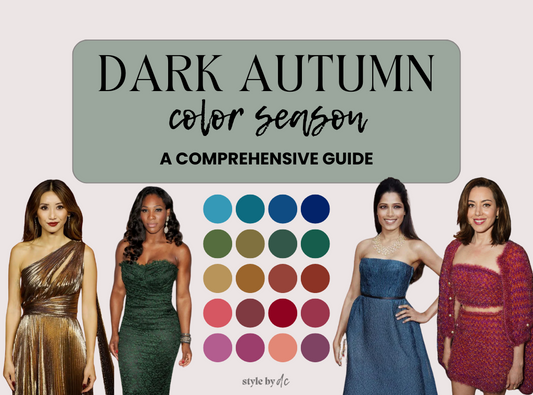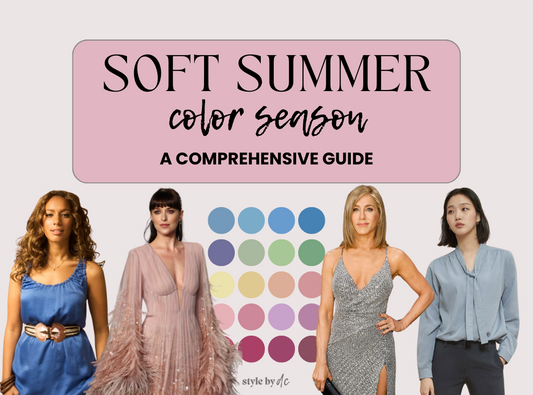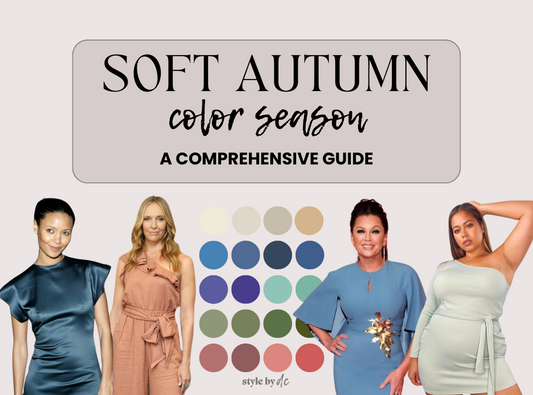Seasonal color analysis has long been a popular method for determining which colors enhance your natural beauty. While the classic four-season approach (Spring, Summer, Autumn, and Winter) has been the foundation for many, the 16-season system takes this concept to a whole new level of precision. But what exactly is the 16 season color analysis system, where does it come from, and how do the various interpretations of it work? In this blog post, we’ll explore the origins, the evolution, and the nuances of this detailed color analysis method.
The Origins of Seasonal Color Analysis
The roots of seasonal color analysis trace back to the early 20th century with the work of Johannes Itten, a Swiss painter and art theorist. Itten observed that his students naturally gravitated toward certain colors in their paintings, colors that often harmonized with their natural coloring. He identified four basic color types, which corresponded with the seasons: Spring, Summer, Autumn, and Winter.
In the 1980s, Carole Jackson popularized this concept in her book Color Me Beautiful, which introduced the four-season color analysis to the mainstream. Jackson’s method categorized people based on the undertone of their skin, hair, and eyes, assigning them to one of the four seasonal categories. Each season was associated with a specific palette of colors that were believed to be most flattering for that person.
The Evolution to 12 and 16 Seasons
As color analysis gained popularity, practitioners began to notice that not everyone fit neatly into one of the four seasons. Some people displayed characteristics of two or more seasons, leading to the development of a more nuanced system—the 12-season method. This system introduced three subcategories for each season, refining the analysis to include Light/Dark, Warm/Cool, and Bright/Muted variations within each primary season.
Eventually, color analysts recognized that even the 12-season system didn’t capture the full range of human coloring. So the idea of expanding outside of the 12 seasons was born. These 16 season methods break down the seasons even further, providing a highly customized approach that accounts for subtle differences in undertone, contrast level, and depth of color. Each of the 16 season systems account for when you fall "in between" two or more of the 12 seasons - so if you've had a tricky time figuring out your season, this could be for you!
Here's the thing though - there are several 16 season systems - not just one. And this is where a lot of confusion comes in!
Before we dive into each of these systems, let's refresh on the classic 12 season. For a full breakdown of the 12 season system, check out the post 'What is Colour Analysis'.
Spring:
- Light Spring: Light, warm, and delicate colors. Think soft peach, light coral, and pale aqua.
- Warm Spring: Warm, bright colors with a golden undertone. Includes shades like warm yellow, coral, and light turquoise.
- Bright Spring: Vibrant, warm colors with a high level of contrast. Colors like bright coral, kelly green, and cobalt blue are ideal.
Summer:
- Light Summer: Light, cool pastels that are soft and airy. Includes shades like soft pink, pastel blue, and light lilac.
- Cool Summer: Cool, muted colors with a gentle softness. Think lavender, cool pink, and sky blue.
- Soft Summer: Muted, neutral colors with a slightly cool undertone. Dusty rose, soft blue-green, and muted lavender are perfect.
Autumn:
- Soft Autumn: Soft, warm, and muted colors with a hint of coolness. Colors like soft peach, muted sage green, and dusty rose work well.
- Warm Autumn: Warm, rich colors with a golden undertone. Mustard yellow, tomato red, and warm olive green are ideal.
- Deep Autumn: Deep, warm, and rich colors with a strong presence. Dark chocolate brown, deep teal, and burnt orange are perfect.
Winter:
- Cool Winter: Cool, clear colors with a sharp, bright undertone. True blue, fuchsia pink, and icy gray are ideal.
- Bright Winter: High-contrast, vibrant colors with a cool undertone. Colors like electric blue, bright red, and crisp white are perfect.
- Deep Winter: Deep, intense colors with a cool undertone. Black, dark burgundy, and forest green work well.
The image below shows where each of these seasons fall on a spectrum between cool and warm, light and deep, and bright and soft/muted.

Understanding the 16 Seasons
The 16 season color analysis systems are based on the idea that each person has a unique combination of undertone (warm or cool), value (light or dark), and chroma (clear or muted). By refining the four basic seasons into 16, these systems allow for a more tailored analysis, ensuring that individuals can find the exact palette that suits them best.
Different Interpretations of the 16-Season System
If you've ever tried searching for the 16 Season Color Analysis system, you likely didn't have luck - because there isn't one standard. Instead, there's several different takes on this concept of being "between" any of the 12 seasons.
Here are some of the more popular ones:
The Sci\ART Method
 This system, developed by Kathryn Kalisz, is one of the most widely recognized approaches to the 16-season system. Where the Sci\ART method is different than the 12 season system is that it separates out a 'True' season for each - creating four categories under each of the four seasons. In the 12 season system, these are combined as the same thing (for example True/Warm Autumn). The 16 seasons are:
This system, developed by Kathryn Kalisz, is one of the most widely recognized approaches to the 16-season system. Where the Sci\ART method is different than the 12 season system is that it separates out a 'True' season for each - creating four categories under each of the four seasons. In the 12 season system, these are combined as the same thing (for example True/Warm Autumn). The 16 seasons are:
Spring: True, Warm, Light and Bright
Autumn: True, Warm, Deep and Soft
Winter: True, Cool, Deep and Bright
Summer: True, Cool, Soft and Light
4x4 Color System

This approach divides the seasons into four quadrants (Winter, Summer, Spring, Autumn), with each quadrant containing four sub-seasons based on color attributes (Pure, Tone, Tint and Shade). This makes the following "seasons":
Winter: Pure Winter, Toned Winter, Tinted Winter, Shaded Winter
Autumn: Pure Autumn, Toned Autumn, Tinted Autumn, Shaded Autumn
Spring: Pure Spring, Toned Spring, Tinted Spring, Shaded Spring
Summer: Pure Summer, Toned Summer, Tinted Summer, Shaded Summer
Tonal Color Analysis

The tonal color analysis system includes 4 additional seasons beyond the typical 12 season system that account for those that have one of their dimensions of color more dominant than the rest and who are typically neutral rather than strongly cool or warm. For example, someone would fall into the True Soft category if they suit colors from both the Soft Summer and Soft Autumn palettes (or in between) and their dominant trait is their softness. This is the main system I practice as a color analyst in my color analysis service, taking cues from the others in order to find the most harmonious colors.
Winter: True/Cool Winter, Bright Winter, Deep Winter
Autumn: True/Warm Autumn, Deep Autumn, Soft Autumn
Spring: True/Warm Spring, Light Spring, Bright Spring
Summer: True/Cool Summer, Light Summer, Soft Summer
Tonal: True Soft (between Soft Summer and Soft Autumn), True Light (between Light Spring and Light Summer), True Bright (between Bright Winter and Bright Spring), True Deep (between Deep Winter and Deep Autumn)
Custom Systems

I've also heard of other 16 system variations that account for being in between seasons - but on the basis of cool and warm. For example, a series of videos by YouTube creator Style Me Jenn explores 4 additional seasons:
Warm Seasons: Soft Spring and Light Autumn (for those in between Spring and Autumn)
Cool Seasons: Deep Summer and Soft Winter (for those in between Summer and Winter)
House of Color

You may have heard some custom sounding terms when it comes to season names and these belong to the House of Color system. While each season can roughly be matched to that of the other 16 season systems (which I've put in brackets), there are variations on how each one is interpreted. Their seasons include:
Winter: Jewel (True), Burnished (Deep), Sprinter (Bright), Sultry (Cool)
Summer: Sweetpea (True), Pastel (Light), Deep and Soft
Autumn: Leaf (True), Soft, Blue (Deep), Vibrant (Warm)
Spring: Golden (True), Pastel (Light), Blue (Bright), Paintbox
The Benefit of the 16 Season Systems
The beauty of any of the 16-season systems is its ability to cater to the diversity of human coloring. By refining the classic four-season approach, it allows you to discover a color palette that truly complements your unique features. This level of customization can make a significant difference in how you feel about your wardrobe and overall appearance. Any of these systems can be very helpful for those that may not fit into the box of one of the 12 seasons.
The Complexity of the 16 Season Systems
Because there isn't one standardized 16 season system, this leads to tons of confusion between different systems - especially when there is a lack of information online. This can make things really tricky if you're trying to DIY color analysis or trying to learn for yourself. If you've been typed as one of the less popularized 16 seasons, it may be hard to find your palette or shopping suggestions other than what your analyst provided to you.
Whether you've been typed in the 12 or one of the 16 season color analysis systems, either offer a highly personalized approach to finding the colors that best suit you. By understanding your specific undertone, value, and chroma, you can refine your wardrobe to reflect your true self.
If you find all of this way too confusing and time consuming, check out my Colour Analysis service. I use color theory as well as the 12 and 16 season systems to determine the palettes that will work best for you!




